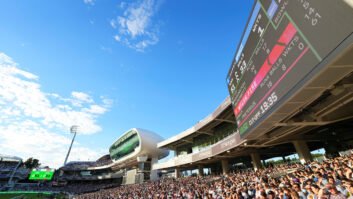
Opened in 2001, the National Space Centre is a visitor centre and educational facility focused on space science. One of the UK’s most successful millennium projects, it welcomes over 300,000 visitors a year and boasts the largest planetarium in the UK at 58ft, with 196 seats.
The reason for the update was the old projectors only worked with 2.5K dome performance and would not work with the National Space Centre’s planned reduced gain dome.
Typically, planetarium upgraders would choose a high-end projector, but with limited budgets the National Space Centre decided to look beyond the traditional planetarium projector providers.
There were several challenges unique to planetariums that had to be considered. Hemispherical projection creates strong cross-bounce of light, which badly compromises the projected image contrast. To compensate for this, the National Space Centre wanted to change the colour of the planetarium dome, pushing the colour (screen gain) down to a very dark grey – beyond anything usually attempted with planetariums. This would only be practical if several very bright HD projectors could be coordinated to produce a high resolution, bright single hemispherical image. In addition, some of the projectors would need to be mounted at extreme angles in order to project to the top of the dome (zenith).

“Our subsidiary organisation, Creative Services, had previously worked with BenQ to upgrade other planetariums across the UK and recommended that we speak to them,” said Graham Law, chief engineer at the National Space Centre. “The BenQ team were very helpful from start to finish, they took time to understand our specific requirements and came up with an superb solution using the LU9915 model.”
The BenQ LU9915 BlueCore laser projector features 10,000 ANSI-lumen brightness, 100,000:1 contrast ratio and also runs very quietly – an important feature when running multiple projectors simultaneously.
BenQ loaned the National Space Centre multiple LU9915 projectors to allow development testing of both spherical image blending and screen gain, and worked with the technical team to modify the projectors’ firmware to control the power of the laser light source in a manner suitable for efficient planetarium use.
“The LU9915 projector is a very cost-effective solution to give a 5K+ image over the centre of the dome, whilst being able to produce a total of 130,000 lumens of light in our configuration before mechanical blending,” commented Law. “This produces deep blacks with the new low gain screen, but also powerful bright high-resolution imagery when required.”
Following successful tests, the National Space Centre design was finalised to comprise 16 LU9915 projectors – 13 are in full-time service, one is dedicated for corporate use, and two are pre-mounted on quick release mounts to enable rapid replacement if required. BenQ was able to arrange a factory batch run for the projectors in order to match them as closely as possible.
The projector also has 3D capability, which is being used in-house by Creative Services to demonstrate new 3D shows created by the National Space Centre production team to planetariums worldwide.







